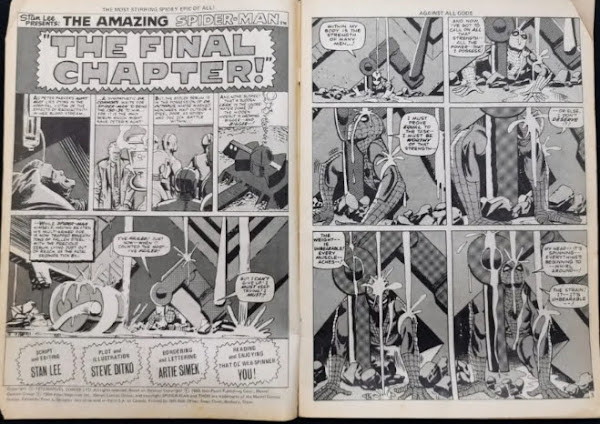Search This Blog
Friday, September 15, 2023
Classic comic book pages: The Final Chapter! - Steve Ditko
The opening pages of Amazing Spider-Man #33 are among the very best in comic book history. Steve Ditko’s image of Spider-Man trapped beneath a heavy piece of machinery in Doctor Octopus’s underwater lab, as the lab slowly fills with water and Spider-Man struggles to break free, are the stuff of comic book legend. The pages below are testament to Ditko’s skill as a vital visual storyteller as each panel moves the eye across the page and raises the tension as to whether or not Spidey will survive - of course he does but even now some 50 years after I first read this story as a 13-year-old , I still remember the excitement that these pages generated.
“The Final Chapter!” is Steve Ditko’s crowning glory on Spider-Man in a series where he regularly pushed the boundaries of what comic book art and storytelling could be, five issues later and Ditko would leave the character to be replaced by the equally talented John Romita Sr. who would take Peter Parker and Spider-Man to even greater hights of popularity.
"The Final Chapter!" story has been reprinted many times in various collections and reprint comics including "Marvel Tales" issue 26 from May 1970 (where the above pages are taken from) and later in issue 172 of the same title in 1985. The cover of Amazing Spider-man issue 33 (at the heading) is taken from Marvel Wiki.
I first read this story in "Spider-Man Comics Weekly" issue 27 (August 1973) and have held on to my original copy since that day. Not even the over use of "grey tone" in the art diminishes Ditko's amazing art on this story.
Above the opening pages of "The Final Chapter!" as they appeared in "Spider-Man Comics Weekly " issue 27.
Subscribe to:
Post Comments (Atom)
Happy New Year
All the best to everyone for 2026. I sometimes wish it was 1974 as in the above SHAZAM! Bob Oksner cover, but at least we can revist the ...

-
As mentioned in my previous post I have been on a bit of a back-issue comic buying spree recently picking up some of the comics I eithe...
-
In 1978 DC began a marketing campaign that would introduce a wave of new comics in an attempt to gain ground on the the publishing jugge...
-
I was probably about seven years old when I walked into my local newsagents in Cambuslang (near Glasgow) with my pocket money firmly he...











It's a great moment in Spidey's history and Steve Ditko claims he plotted it with no input from Stan Lee before he (Ditko) drew it. Stan was once asked about the story and responded as if he had a hand in it, but I think this was more down to his poor memory than trying to hog credit for it. Therefore, I believe Ditko's account, though it has to be said that I think it was Lee's scripting that gave the page a huge slice of the drama it contained and fulfilled its potential promise. Stan-haters will claim otherwise, but without Stan's dialogue, it would be an interesting series of sequential pictures, without the turmoil in Peter Parker's/Spidey's soul.
ReplyDeleteI just assumed that Stan wrote it and Ditko interpreted it as above. Regardless, it's a cracking story and set of pages. Just a shame Stan, Kirby and Ditko seem to have fallen out over these things. As a kid all I knew was I loved their work, that's what counts.
ReplyDeleteI liked the use of grey tone in the Marvel UK weeklies.
ReplyDeleteFor me it had its place Colin but I felt Marvel UK over did the use of grey tone. To be fair, this wasn't the the worst example of its use but for me it was still a tad overdone.
ReplyDeleteCertainly this was Steve Ditko at his peak. Contrast the superb, powerful artwork here with the lacklustre work he did on the Creeper's return in First Issue Special #7 at DC seven years later. I always felt that after Spider-Man and Doctor Strange, Ditko's heart just wasn't in the work any more.
ReplyDeleteI found the drop in Ditko's art quality staggering and he wasn't that old at this time either . Other artists like Severin, Russ Heath, Alex Toth, John Buscema and Neal Adams at that age were still creating top notch work. Still at his best Ditko was one of very best.
ReplyDelete